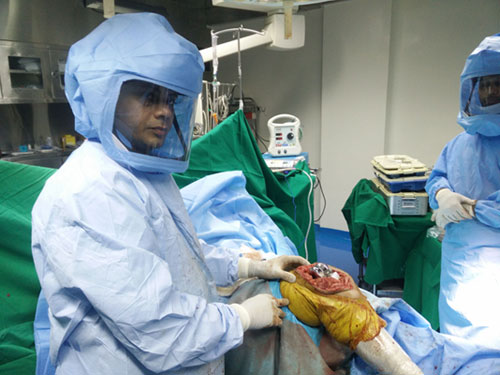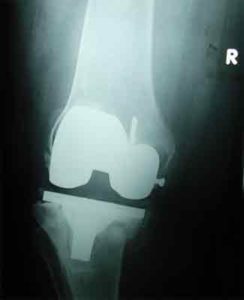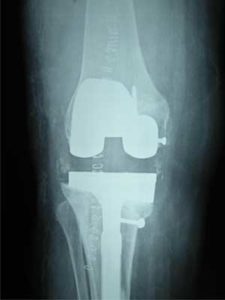Indications for Revision Total Knee Replacement Surgery
When an Artificial Knee Joint fails, a second operation is required to replace the failing joint. This procedure is called a Revision Joint Replacement.
The most common reasons for a Revision Total Knee Replacement Surgery are as follows:
- Mechanical loosening.
- Infection in the joint.
- Fracture of the bone around the joint.
- Instability of the implant.
- Wear of one or more parts of the implant.
- Breakage of the implant.

Dr. Amyn Rajani Performing Revision Total Knee Replacement Surgery
Mechanical Loosening:
Mechanical loosening means that the attachment between the artificial joint and the bone becomes loose due to some reason (other than infection). Loosening can occur after a period of extensive use of the joint. This could be as much as 10 to 15 years. This is one reason that surgeons like to wait until absolutely necessary to put in an artificial joint. The younger you are when an artificial joint is put in, the more likely it is that the joint will loosen and require a revision.
Infection:
If the artificial joint gets infected, it has to be removed to cure the infection. Once the infection settles down a Revision Total Knee Replacement Surgery is done for the patient. Till the time the new implant is put, a cement spacer impregnated with antibiotic is put inside the Knee to give it stability.
If the infection does not come under control, a new implant cannot be inserted and hence fusion of the Knee is the only option.

Pre-Operation X-Ray for Revision Total Knee Replacement Surgery

Post Operation X-Ray for Revision Total Knee Replacement Surgery
Fracture:
A fracture may occur near an artificial joint. It is sometimes necessary to use a new artificial joint to fix the fracture. For example, if the femur (thighbone) breaks where the prosthesis attaches, it may be easier to replace the femoral part of the artificial joint with a new piece that has a longer stem that can hold the fracture together while it heals. This is similar to fixing the fracture with a metal rod.
Instability:
It is not uncommon for the Knee Joint to be either too tight or too loose. If the Knee Joint is too loose, it can cause unsteadiness and pain. If the joint is too tight, the Knee is usually painful and doesn't have a good range of motion. In situations like these a revision becomes necessary.
Wear:
With the rise in Knee Joint Replacements, surgeons have begun to see wear in the plastic parts of the artificial joints. In some cases, if the wear is discovered in time, the revision may only require changing the plastic part of the artificial joint. If the wear continues until the metal is rubbing on metal, the whole joint may need to be replaced.
Breakage:
Finally, the metal of the artificial joint can break due to the constant stress that the artificial joint undergoes every day. In weight-bearing joints like the Knee, this is greatly affected by how much you weigh and how active you are.

